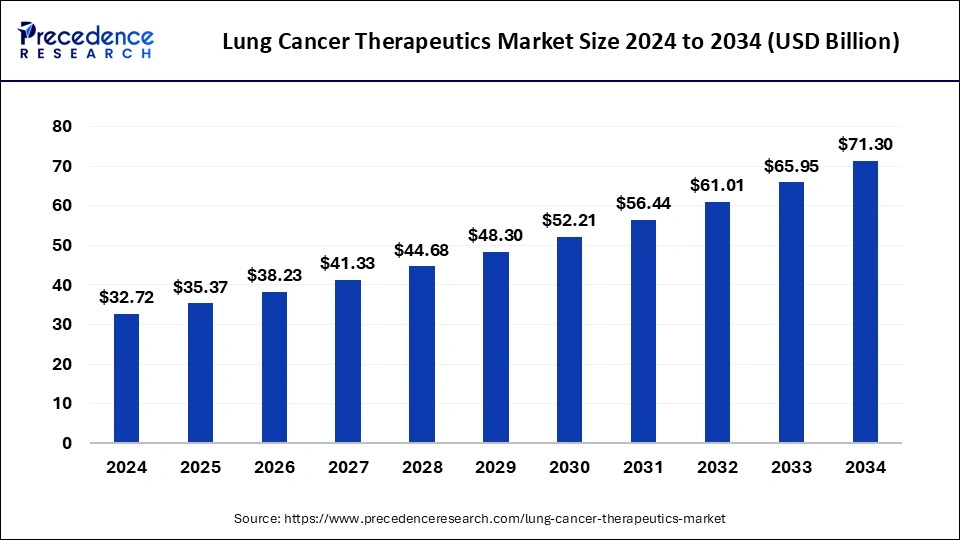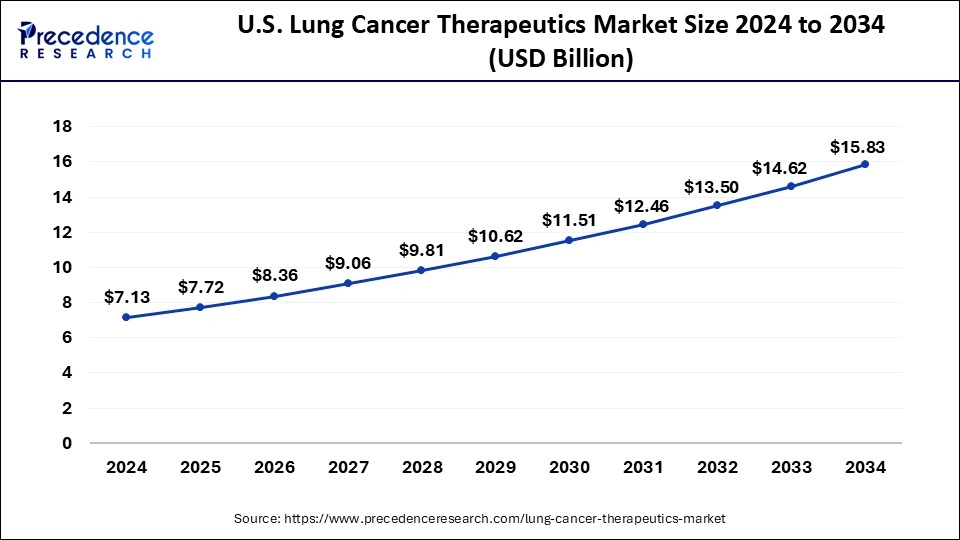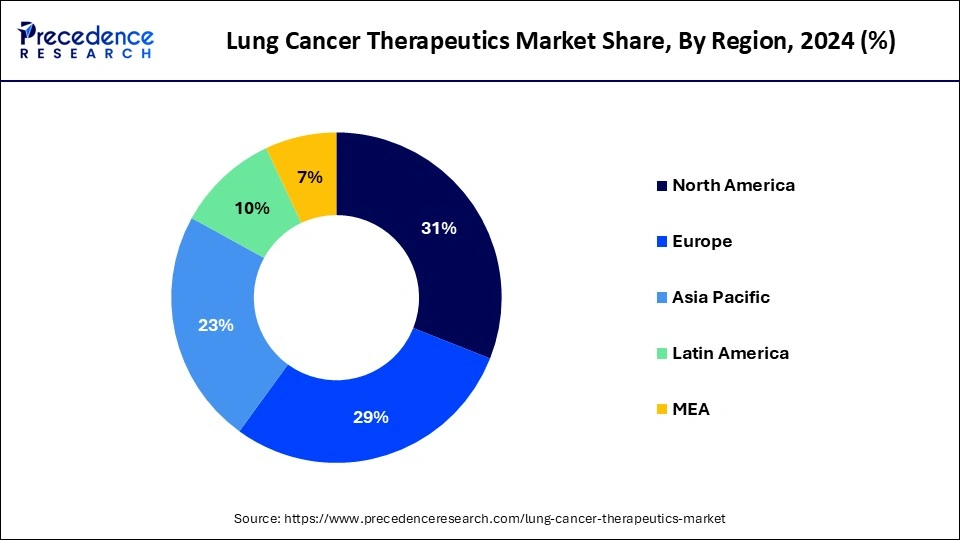List of Contents
Lung Cancer Therapeutics Market Size and Forecast 2025 to 2034
The global lung cancer therapeutics market size was calculated at USD 32.72 billion in 2024 and is predicted to increase from USD 35.37 billion in 2025 to approximately USD 71.30 billion by 2034, expanding at a CAGR of 8.10% from 2025 to 2034.

Lung Cancer Therapeutics Market Key Takeaways
- North America led the global market with the highest market share of 31% in 2024.
- By therapy, the targeted therapy segment is estimated to capture the biggest revenue share of 50% in 2024.
- By lung cancer type, the non-small cell lung cancer segment is predicted to register the maximum market share in 2024.
- By distribution channel, the hospital pharmacies segment is estimated to hold the highest market share in 2024.
U.S. Lung Cancer Therapeutics Market Size and Growth 2025 to 2034
The U.S. lung cancer therapeutics market size was exhibited at USD 6.58 billion in 2024 and is projected to be worth around USD 15.83 billion by 2034, growing at a CAGR of 8.30% from 2025 to 2034.

North America was the leading lung cancer therapeutics market in 2024 and it is expected to remain dominant throughout the forecast period. The rising prevalence of lung cancer and growing adoption of advanced diagnosis and lung cancer therapeutics for the treatment of lung cancer has resulted in the increased demand for lung cancer therapeutics in this region. The presence of several top biopharmaceutical companies in this region has immense contributions in the development and growth of the lung cancer therapeutics market. Furthermore, the increased penetration of health insurance in North America, has resulted in the improved access to the advance and costly therapeutics. Moreover the presence of a strong and developed healthcare infrastructure and improved access to the advanced healthcare facilities in the region has significantly contributed towards the growth of the market. The government authority like the US FDA has exponentially worked towards the monitoring and approving various advanced therapies in the region.

Asia Pacific is estimated to exhibit the highest CAGR during the forecast period. The rising prevalence of smoking and exposure to secondhand smoke is resulting in the growing prevalence of lung cancer among the population. The rapidly growing government investments in the development of advanced healthcare facilities and the rising penetration of healthcare insurancesin the market has improved the access to advanced healthcare facilities. Furthermore, the rising investments of the top biopharmaceutical companies in the Asia Pacific region to expand their manufacturing facilities and produce advanced drugs at low cost is significantly driving the growth of the market.
Lung Cancer Therapeutics Market Growth Factors
Cancer is a gene related disease that cells grow abnormally during the mutation. These cells flow from the original site to other sites through blood and lymph. Lungs cancer is the most prevailing type of cancer across the globe and it affects the lung tissues. Lungs cancer creates difficulties in supplying oxygen to the blood. Lungs cancer has the highest mortality rate among both the male and female population and the majority of the lungs cancer are the non-small cell lung cancer.
The global lung cancer therapeutics market is projected to witness a significant growth owing to the surging prevalence of lungs cancer among the global population. According to the GLOBOCAN 2020 estimates by the International Agency for Research on Cancer, there were around 19.3 million new cases of cancer recorded in 2020 and around 11.4% of it was lungs cancer. Lung cancer was the leading cause of death with around 18% or 1.8 million global deaths in 2020. The incidences of lung cancer are growing rapidly across the globe owing to the increasing prevalence of smoking and exposure to second hand smoke.
Market Scope
| Report Coverage | Details |
| Market Size by 2034 | USD 71.30 Billion |
| Market Size in 2025 | USD 35.37 Billion |
| Market Size in 2024 | USD 32.72 Billion |
| Growth Rate from 2025 to 2034 | CAGR of 8.10% |
| Largest Market | North America |
| Fastest Growing Market | Asia Pacific |
| Base Year | 2024 |
| Forecast Period | 2025 to 2034 |
| Segments Covered | Therapy, Lung Cancer Type, Distribution Channel, Drug Class, and Type of Molecule |
| Regions Covered | North America, Europe, Asia-Pacific, Latin America, and Middle East & Africa |
Therapy Insights
Based on the therapy, the targeted therapy was the leading segment that accounted for over 50% of the market share in 2024. Targeted therapy has gained a significant traction among the lung cancer patients. The rapid growth of the biopharmaceutical industry and the rising research and development expenses has resulted in the development of advanced targeted therapeutics to treat lung cancer. The targeted therapy can effectively treat the cancer cells without altering the normal cells of the body. This results in minimal side-effects and eliminates the chances of reoccurrence and deaths. The rising healthcare expenditure along with the growing awareness regarding the availability of advanced gene therapies that can cure the traditionally non-curable diseases has significantly fueled the growth of the targeted therapy across the globe.
The immunotherapy is anticipated to be the most opportunistic segment during the forecast period. The immunotherapy uses the immunity system to eliminate, prevent, and control the cancer causing cells in the body. It enhances the immune system and educates the immune system to identify the cancer cells and attack those specific cells to treat the lung cancer. Immunotherapy is considered to be a smart way to prevent cancer cells and it is rapidly gaining traction among the cancer patients. Therefore, the immunotherapy is anticipated to be the fastest-growing segment in the global lung cancer therapeutics market.
Lung Cancer Type Insights
Based on the lung cancer type, the market is divided into non-small cell lung cancer, small cell lung cancer, and lung carcinoid tumor. The non-small cell lung cancer segment dominated the global lung cancer therapeutics market in 2024. This growth is primarily attributed to the increased prevalence of non-small cell lung cancer among the population. The treatment of the non-small cell lung cancer totally depends on the stages of this cancer. It is estimated that around 80% of the lung cancer are non-small cell lung cancer and hence the demand for the lung cancer therapeutics to cure this type of lung cancer has propelled the growth of this segment in the global lung cancer therapeutics market.
The small cell lung cancer is expected to be the fastest-growing owing to the growing prevalence of smoking and as a result the rising prevalence of small cell lung cancer. The rising awareness among the patients regarding the small cell lung cancer and the availability of advance therapeutics to cure it is expected to drive the demand for the lung cancer therapeutics across the globe.
Distribution Channel Insights
Based on the distribution channel, the hospital pharmacies segment dominated the market in 2024. The increased volume of patient admissions in hospitals for receiving the treatment and diagnosis of cancer has significantly boosted the sales of the lung cancer therapeutics from the hospital pharmacies across the globe. Moreover, the increased preference among the consumers to buy drugs from hospital pharmacies owing to the availability of huge variety drugs has resulted in the dominance of this segment.
The online pharmacies segment is anticipated to be the fastest-growing segment during the forecast period. The rising penetration of the digital media and improving access to the internet has boosted the e-commerce. The rapid emergence of the online pharmacies segment has gained popularity among the customers owing to the ease and conveniences associated with the online pharmacies.
Lung Cancer Therapeutics Market Companies
- AstraZeneca
- BoehringerIngelheim
- Bristol-Myers Squibb Company
- Eli Lilly and Company
- Hoffmann-La Roche
- Merck & Co
- Pfizer Inc.
- Allergan Inc.
- TevaPharmaceutical Industries Ltd.
- Abbvie, Inc.
- Johnson & Johnson
- Amgen Inc.
- Novartis AG
Recent Developments
The lung cancer therapeutics market is moderately fragmented with the presence of several top players in the market. These market players are constantly engaged in various developmental strategies such as mergers, joint ventures, business expansion, acquisitions, partnerships, collaborations, and new product launches to strengthen their position and expand their market share.
- In March 2019, Adorx Therapeutics entered into a strategic agreement and partnered with Johnson & Johnson Innovation for developing innovative lung cancer therapeutics.
- In May 2021, Amgen acquired the FDA approval for its LUMAKRAS that is used for the treatment of non-small cell lung cancer
Segments Covered in the Report
By Therapy
- Radiation Therapy
- External Beam
- Internal Beam
- Systemic
- Targeted Therapy
- Bevacizumab
- Dabrafenib/Trametinib
- Erlotinib Hydrochloride
- Osimertinib
- Others
- Immunotherapy
- Durvalumab
- Nivolumab
- Atezolizumab
- Pembrolizumab
- Chemotherapy
- Others
By Lung Cancer Type
- Small Cell Lung Cancer
- Non-small Cell Lung Cancer
- Lung Carcinoid Tumor
By Distribution Channel
- Hospital Pharmacies
- Retail Pharmacies
- Online Pharmacies
By Type of Molecule
- Small molecules
- Biologics
By Drug Class
- Alkylating Agents
- Antimetabolites
- EGFR Inhibitors
- Mitotic Inhibitors
- Multikinase Inhibitors
- Others
By Geography
- North America
- U.S.
- Canada
- Europe
- U.K.
- Germany
- France
- Asia-Pacific
- China
- India
- Japan
- South Korea
- Malaysia
- Philippines
- Latin America
- Brazil
- Rest of Latin America
- Middle East & Africa (MEA)
- GCC
- North Africa
- South Africa
- Rest of the Middle East & Africa
For inquiries regarding discounts, bulk purchases, or customization requests, please contact us at sales@precedenceresearch.com
Frequently Asked Questions
Ask For Sample
No cookie-cutter, only authentic analysis – take the 1st step to become a Precedence Research client